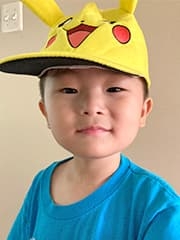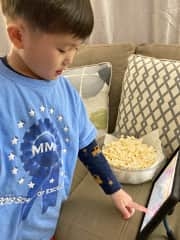Autism, Language Disorder, and Augmentative and Alternative Communication: Julian’s Story
Published on
Published on
Like most mothers, Theresa is a bit of a mind-reader. But with her son Julian, she had to use those mind-reading superpowers constantly — until a few months ago.
That is when 5-year-old Julian, who is on the autism spectrum and nonspeaking, began to use an augmentative and alternative communication (AAC) device to communicate. Now Julian can quickly get the device to say the words for what he wants. And, in an even more exciting development, he has started to say many of the words as well.
“We have seen such a great improvement,” Theresa says. “It’s truly amazing. We have CHOP to thank.”
 A combined developmental pediatric and speech-language evaluation at Children’s Hospital of Philadelphia (CHOP) when Julian was 2½ concluded he had autism. He started speech-language therapy through the Montgomery County Intermediate Unit. But COVID-19 meant the sessions were online, which didn’t work for an active preschooler. “He could not sit still for 5 minutes,” Theresa says.
A combined developmental pediatric and speech-language evaluation at Children’s Hospital of Philadelphia (CHOP) when Julian was 2½ concluded he had autism. He started speech-language therapy through the Montgomery County Intermediate Unit. But COVID-19 meant the sessions were online, which didn’t work for an active preschooler. “He could not sit still for 5 minutes,” Theresa says.
Julian began attending a private clinic for therapy, which was better, but his speech was still nonexistent. A speech-language evaluation at CHOP’s Center for Childhood Communication (CCC) by speech-language pathologist Marianne Decicco, MS, CCC-SLP, determined he had limited functional communication.
If he wanted a snack, he’d grab his mother’s hand and pull her into the kitchen. Then her mind-reading kicked in: An apple? A cookie? Some juice? “He would just drag us where he wanted to go,” Theresa says. “Luckily, he’s a calm child and didn’t get frustrated or act out.” But his parents realized it was an unworkable system going forward. “In school, they aren’t going to read his mind.”
DeCicco recommended an AAC evaluation. At this appointment, the family met with Laura Morris, MS, CCC-SLP, one of the speech-language pathologists in the CCC who specializes in matching a child’s communication needs with the type of AAC system that will work best for them. After exploring several systems, an AAC device was picked for Julian and a plan was put into place: Julian would trial this device for some time and start outpatient speech-language therapy, with a focus on learning how to use the device for communication purposes.
Over four training sessions with speech-language pathologist Haley Hirzel, MS, CCC-SLP, conveniently held at the CHOP Specialty Care Center in Bucks County near the family’s home, Hirzel taught Julian how to use the device.
“Julian was able to catch on so fast,” Theresa says. “Haley was so patient with him. She guided him and didn’t rush him. He listened to Haley and just took off!”
He selects a category, such as “I want to,” and a window pops up with options, like “play” or “eat.” He selects one and then scrolls through more screens to find a picture of the item he wants. The device says each word as Julian builds his sentence.
“He mimics the device. The voice says, ‘I want to play ball … ball … ball.’ And he’ll repeat it: ba, ba, ba,” Theresa says. “It’s exciting for us. In just a couple of months, he has gone from having not even a handful of words to having 40 or 50.”
Hirzel also made sure Theresa, Julian’s dad, Joe, and his older brother, Adrian, all know how the device works so they can model how to use it at home. It didn’t take long, though, before Julian was the expert in the family.
 After the trial period, it became clear that the AAC device was a great fit for Julian and his team of speech-language pathologists at CHOP helped Julian to get one to keep. Julian will be starting kindergarten this fall, so being able to communicate with his teachers and classmates will be key to having a productive and fun learning experience.
After the trial period, it became clear that the AAC device was a great fit for Julian and his team of speech-language pathologists at CHOP helped Julian to get one to keep. Julian will be starting kindergarten this fall, so being able to communicate with his teachers and classmates will be key to having a productive and fun learning experience.
He takes the AAC device to his preschool, and his teacher reported to Hirzel that he’s already using it to “talk” with fellow students. When another child asked him, “What’s that?” Julian responded using a preprogrammed phrase, “This is my communication device.”
Julian has also started initiating communication with his family — which is a new skill — and inquiring about new and different things he sees. The eventual goal is for Julian to be able to have conversations, to describe his day or how he’s feeling, building on his current use of individual words.
““He’s learning step by step. We are so happy with his progress,” Theresa says. “He has always been a happy kid, and now his personality is coming out even more since he’s able to express himself. It’s helped him become more independent. It’s awesome.””